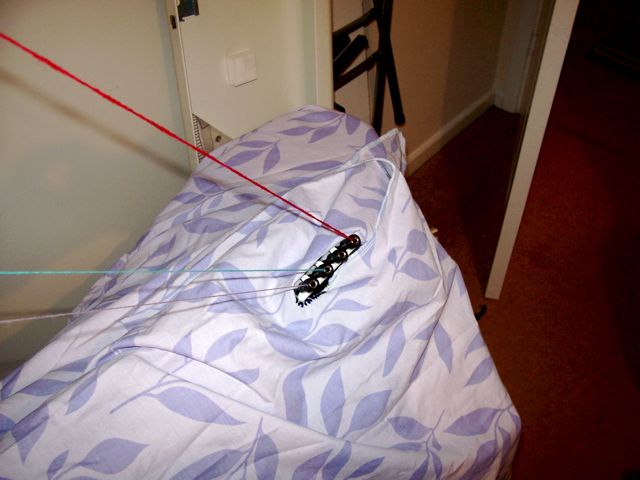For those folk who don't cover their machines - believe me, it's far better to cover them than to have to clean them constantly, especially if they sit unused for weeks at a time. And my kitty likes to use the Japanese machine as a springboard to get to the windowsill, so it's worth it for that reason too! He's also discovered the covered machines make a great hiding place when I want to put him out for the day and he doesn't want to go.
So a few months back I was having a sort out, and decided to pension off one of the king size duvet covers - the colours had faded unevenly, so it looked a bit odd on the bed, but the material itself was sound. I ripped the cover apart (boy, that was fun!) and overlocked (US=serged) the edges to neaten them, and then got measuring!
The Brother one (which will fit most Japanese machines) was pretty easy, as I only have the one tension mast - I draped the sheet over the machine and checked how deep I thought the slit should go, and it was about halfway across and halfway to the centre (see below):

Your mast may not be dead centre, or you may have two masts installed, in which case, measure accordingly!
The Passap E6000 was a little more tricky, as it has a console arm and two masts, and a colour changer that stands up on the right hand side. Again, you need to place it on the machine, and drape the sheet so that the front edge is where you want it.

Measurement A is the console arm to the first mast, and B is the first mast to the second mast. Because the Passap masts are a bit further back, you might not need to cut the slits as deep as for the Japanese cover.
The side slit is for the colour changer. When the cover is finished, I use a clothes peg to hold the upper and lower pieces together over the machine.
Finished passap cover:

Colour changer end:

Note about overlocking slits in fabric - you have to open the material right out at the bottom of the slit, so that it is presented to the overlocker blade as a straight edge, otherwise it will cut but not sew and will make a bit of a mess. Practice on some scrap fabric first! :)

2 comments:
Thanks for the pattern!
I have bought an old machine cover on eBay that is too heavy and stiff to use.
This sounds a lot more sensible.
hehe I thought you were going to say what I use but you went fancy and sewed it :P
I am only new and only just bought a knitting machine and it came with this smokey,smelly heavy felt cover.
That got thrown out straight away, and all I use is a folded over doona cover I bought for the fabric.
I like it doubled over as with the single fabic, in my head I can see dust etc still getting through... but my head is always wrong.
anyway.. haha yay! for the old doona cover! :)
Post a Comment